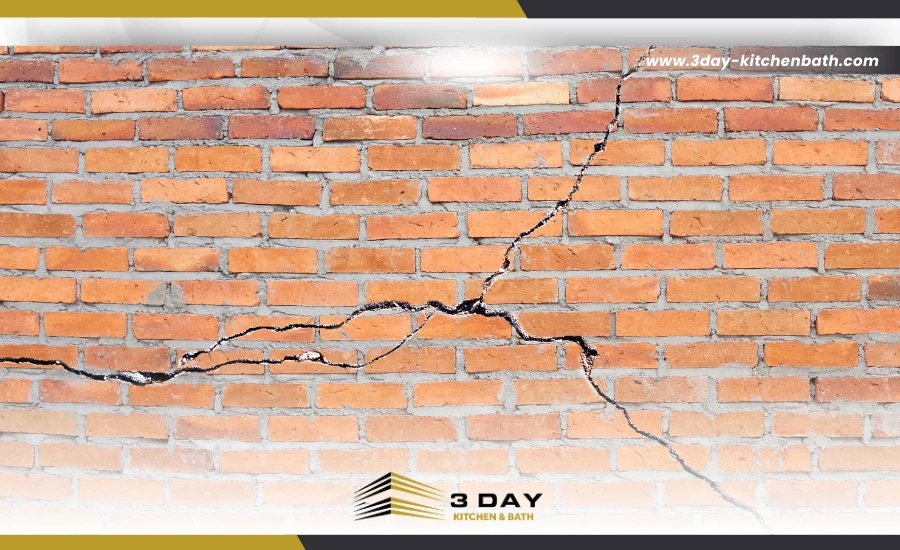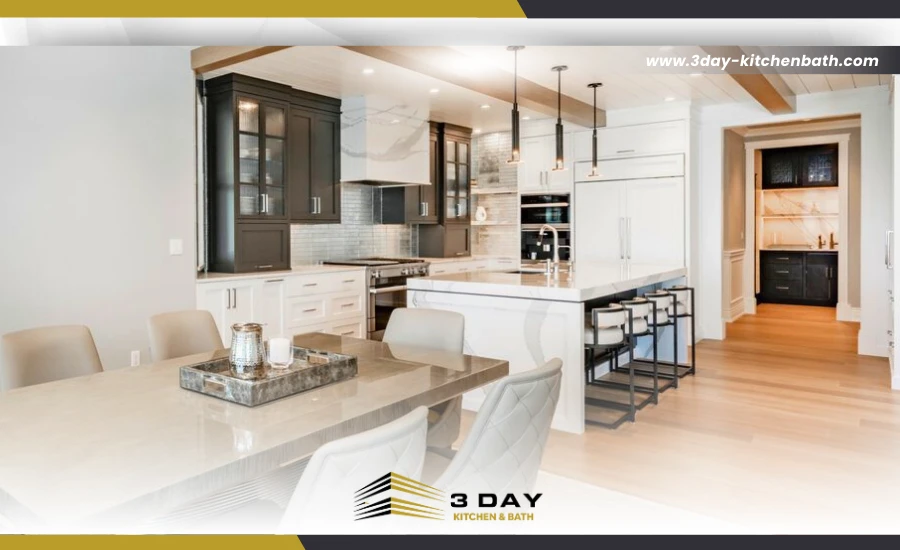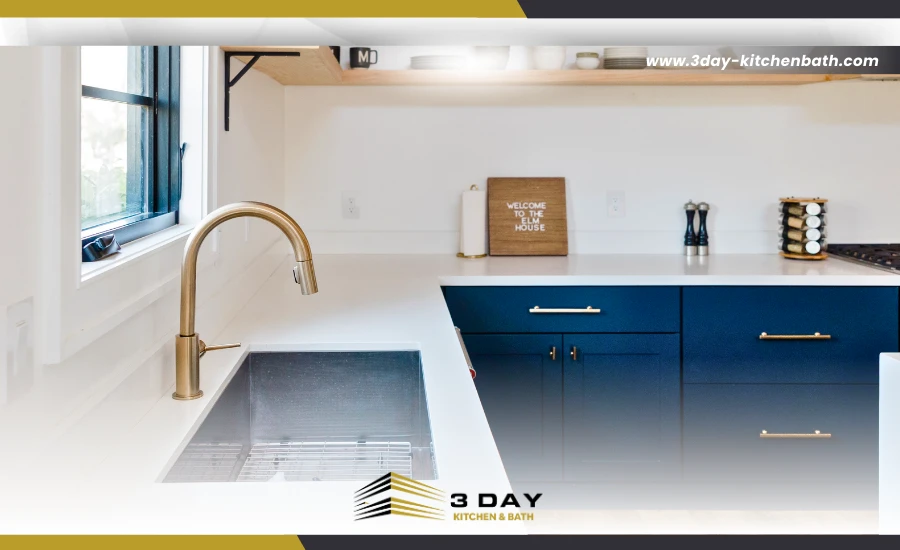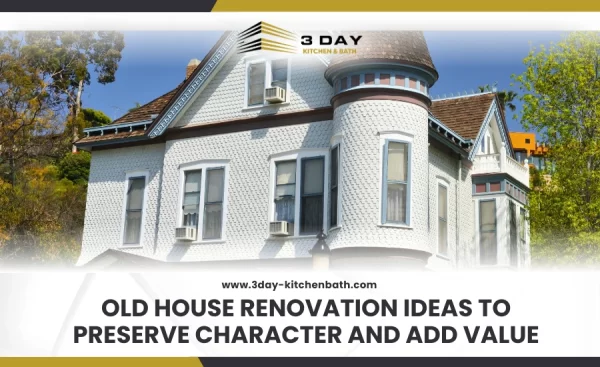Renovating an old house is a unique process that requires careful planning and attention to detail. Old homes often have hidden structural issues but also feature historical details worth preserving. The goal is to keep the original charm while modernizing the space for comfort and safety. This guide will provide practical old house renovation tips to help homeowners strike the right balance between preserving character and adding value to their homes.
- Planning Your Old House Renovation the Right Way
- Setting Priorities: Tackle Safety First, Beauty Second
- Building a Realistic Budget and Allowing for Contingencies
- DIY vs. Professional Help: Know When to Call in the Experts
- Addressing Structural Concerns: Foundation, Electric, and Plumbing
- Repairing the Foundation and Preventing Future Damage
- Upgrading Outdated Electric and Plumbing Systems
- Preserving Original Features While Adding Modern Comfort
- Restoring Historic Elements: Woodwork, Flooring, and Fixtures
- Balancing Modern Upgrades with Historic Aesthetics
- Budget-Friendly Ideas for Renovating Old Houses
- Smart Renovation Strategies Without Breaking the Bank
- Prioritizing High-ROI Updates for Maximum Value
- Enhancing Room-by-Room: Kitchen, Bath, and Living Spaces
- Kitchen Remodel Ideas That Preserve Historic Charm
- Bathroom Remodels: Merging Modern Comfort with Vintage Style
- Final Touches to Complete Your Old House Renovation
- Paint, Flooring, and Fixtures for a Polished Look
- Before and After: Showcasing the Transformation
- Wrapping Up Your Old House Renovation Journey
- Frequently Asked Questions
- What are the most common mistakes to avoid when renovating old houses?
- How do I choose the right contractor for an old house renovation?
- Is it possible to make old houses energy-efficient without major alterations?
- What are some signs that indicate hidden structural problems in an old home?
- Should I restore old windows or replace them for better efficiency?
- Ready to Transform Your Old House in San Diego?
Planning Your Old House Renovation the Right Way
Proper planning is the foundation of a successful old house renovation. Before starting any work, setting clear goals and prioritizing projects is essential. This will help ensure that the most critical repairs are addressed first, keeping the renovation on track and within budget.
Setting Priorities: Tackle Safety First, Beauty Second
Addressing any urgent structural needs before you focus on making your home look beautiful. Safety concerns like foundation issues, electrical hazards, or roof damage should come first. Once these are fixed, move on to less urgent updates like refinishing floors or repainting walls. Use the following steps to organize your renovation plan:
- Identify Safety Issues First: Inspect your home for foundational cracks, outdated wiring, and plumbing problems.
- Tackle Structural Repairs: These include sheetrock and drywall replacement, roof repairs, and updating old pipes.
- Cosmetic Enhancements: After structural updates, work on painting, flooring, and minor repairs that improve appearance.

Building a Realistic Budget and Allowing for Contingencies
Old houses are known for hidden issues that can derail a budget. Planning for these surprises will help you avoid stress and keep your project on track. Allocate around 10-15% of your total budget for unforeseen problems. Use free tools like ‘HomeZada' to break down costs by room and track your budget in real-time. Here's a simple budgeting framework:
- Break Down Costs by Project: List every task (e.g., old house remodel ideas like kitchen and bathroom updates).
- Add a Contingency Fund: Calculate 10-15% of your total to cover unexpected costs (e.g., mold removal, foundation repair).
- Consider High-ROI Projects: Focus on old house renovation ideas, such as modernizing kitchens and bathrooms, to increase your home's value.
DIY vs. Professional Help: Know When to Call in the Experts
Some tasks can be done yourself, but others are better left to the pros. This will save you time and prevent future problems.
- DIY: Simple tasks like painting, sanding floors, or installing new light fixtures can be DIY-friendly. This saves on labor costs and allows you to invest more in professional work where it's truly needed.
- Hire a Professional: Structural repairs, electrical rewiring, and plumbing upgrades should always be handled by professionals to avoid safety risks and costly future fixes.
Addressing Structural Concerns: Foundation, Electric, and Plumbing
Old homes often have outdated systems that need to be repaired or replaced. Before adding cosmetic updates, ensure your home's foundation, electrical wiring, and plumbing are safe and efficient. This will save you from having to redo work later if major problems arise.
Repairing the Foundation and Preventing Future Damage
The foundation is the backbone of your home. Small cracks can lead to big issues if not properly addressed. When renovating an old house, start by inspecting the foundation for signs of damage:
- Cracks in Walls or Floors: Look for diagonal or stair-step cracks.
- Sloping Floors: Uneven floors can indicate serious foundational issues.
- Water Damage: Check for damp areas or water pooling around the home's exterior.
If you notice these problems, consult a structural engineer or a foundation specialist. Fixing foundation issues early on is crucial to a successful old house renovation.

Upgrading Outdated Electric and Plumbing Systems
Electrical and plumbing problems are common in older homes. Old wiring can be a fire hazard, and aging pipes may lead to leaks and water damage. Upgrading these systems ensures safety and reduces future maintenance costs:
- Replace Outdated Wiring: Old knob-and-tube or aluminum wiring should be upgraded to meet modern codes.
- Install GFCI Outlets: Ground-fault circuit interrupter outlets are required in kitchens, bathrooms, and other wet areas.
- Check Plumbing for Leaks: Inspect pipes for signs of rust, corrosion, or past water damage. Replace old lead pipes as soon as possible.
Addressing these issues early will prevent costly repairs and ensure your old house remodel runs smoothly.
Preserving Original Features While Adding Modern Comfort
Many old houses have unique architectural details and high-quality materials that are hard to find today. These original features are worth preserving because they add character and history to your home. At the same time, ensuring that your home is functional and comfortable for modern living is essential. The following old house renovation tips will help you restore these features while seamlessly integrating modern comforts.
Restoring Historic Elements: Woodwork, Flooring, and Fixtures
Restoring historic elements like wood trim, original flooring, and vintage fixtures can make a big impact on your renovation project. These features reflect the craftsmanship of the time and add warmth to your space. Here are some steps to help restore and preserve these details:
- Refinish Original Wood Flooring: If your home has old hardwood floors, consider sanding and refinishing them rather than replacing them. This maintains the original character and is often more cost-effective.
- Repair and Repaint Moldings and Trim: Scrape off old paint carefully, fill in any gaps or cracks, and repaint using colors that match the home's era.
- Restore Vintage Fixtures: Update old light fixtures or door handles by cleaning and polishing them. If you need to replace parts, look for authentic vintage pieces or high-quality reproductions.
Taking the time to restore these historic details ensures that your old house remodel keeps its charm while meeting modern needs.
Balancing Modern Upgrades with Historic Aesthetics
Adding modern features doesn't have to detract from your home's historical charm. The key is to choose materials and finishes that blend well with the original design. Here are some ways to achieve this balance:
- Use Period-Appropriate Colors and Finishes: Choose paint colors, tile, and cabinetry that complement the home's age and style. Avoid overly modern finishes that clash with historic details.
- Incorporate Modern Technology Discreetly: Hide smart thermostats, speakers, and wiring within cabinetry or behind existing woodwork.
- Update Layouts While Preserving Character: Create an open-concept kitchen or living space without removing essential structural elements like support beams or original wood columns.
Balancing modern updates with your home's original features will create a space that is both functional and true to its historic roots.
Budget-Friendly Ideas for Renovating Old Houses
Renovating an old house can be expensive, but there are many ways to manage costs without sacrificing quality. By being strategic in your choices and focusing on high-impact projects, you can make significant improvements while staying within budget. These old house renovation ideas will help you achieve your goals without breaking the bank.
Smart Renovation Strategies Without Breaking the Bank
Upgrading an old house on a budget is possible if you prioritize projects carefully and use creative solutions. Here are some cost-saving strategies:
- Do Minor Projects Yourself: Simple tasks like painting, sanding floors, or installing new light fixtures can be DIY-friendly. This saves on labor costs and allows you to invest more in professional work where it's truly needed.
- Use Salvaged or Reclaimed Materials: Look for old bricks, tiles, or reclaimed wood for repairs and updates. These materials are often less expensive and help maintain the home's original character.
- Repurpose Existing Features: Keep and restore original cabinets, doors, or built-in shelves. Some restoration work can go a long way if they're in good condition.
With these strategies, you can complete your old house remodel without overspending.

Prioritizing High-ROI Updates for Maximum Value
When working with a limited budget, focus on updates that add the most value to your home. These are typically projects that improve both aesthetics and functionality. Consider these high-return-on-investment ideas:
- Kitchen and Bathroom Remodels: Upgrading kitchens and bathrooms is always a good investment, as these are key selling points for any home. Choose timeless materials and fixtures that fit the style of the house.
- Energy Efficiency Upgrades: Adding insulation, upgrading windows, and replacing old HVAC systems can reduce utility costs and increase your home's value.
- Curb Appeal Enhancements: Small changes like painting the exterior, restoring the front porch, or adding landscaping can make a big impact on the home's appearance and resale value.
Prioritizing these high-ROI projects will help you get the most out of your old house renovation budget.
Enhancing Room-by-Room: Kitchen, Bath, and Living Spaces
When renovating an old house, each room requires special consideration to maintain the overall style while meeting modern expectations. Kitchens and bathrooms are especially challenging because they must be functional and stylish. Using the following old house renovation ideas, you can create beautiful, updated spaces that still respect the home's original character.
Kitchen Remodel Ideas That Preserve Historic Charm
The kitchen is often the heart of the home, and for older houses, it should reflect the home's historical charm while being fully functional. Here's how to update a kitchen without losing its original appeal:
- Keep or Restore Original Cabinets: If the cabinets are still in good condition, consider refinishing them instead of replacing them. To enhance their look, you can add a fresh coat of paint or new hardware.
- Use Period-Appropriate Countertops and Backsplashes: Materials like marble, butcher block, or subway tile can give the kitchen a timeless feel.
- Add Modern Appliances that Blend In: Choose appliances with a vintage-inspired design or integrate them behind cabinetry to maintain a cohesive style.
- Preserve Architectural Details: If the kitchen has unique features like exposed brick walls, original wood beams, or antique moldings, highlight them rather than cover them up.
These old house remodeling ideas for kitchens will allow you to enjoy modern amenities without sacrificing the home's character.
Bathroom Remodels: Merging Modern Comfort with Vintage Style
Bathrooms in older homes are often small, but they can be transformed into elegant spaces that combine classic style with modern conveniences. Here are some ways to modernize a bathroom while keeping a vintage vibe:
- Use Classic Fixtures: Consider clawfoot tubs, pedestal sinks, and vintage-style faucets that match the home's era.
- Install Timeless Tile Patterns: Hexagon tiles, subway tiles, or penny rounds work well in old homes and are available in many colors.
- Add Modern Lighting and Storage Solutions: Use sconces, wall-mounted mirrors, and hidden storage options to enhance functionality while preserving style.
- Incorporate Natural Materials: Marble, porcelain, and wood add warmth and elegance to the space.
By merging classic and modern elements, you'll create a bathroom that fits today's needs while respecting the historic charm of your old house remodel.
Final Touches to Complete Your Old House Renovation
The final details are what ties the entire renovation together. Choosing the right paint, flooring, and fixtures can either highlight the home's historic beauty or detract from it. Use these old house renovation ideas to make sure every corner of your home feels polished and cohesive.
Paint, Flooring, and Fixtures for a Polished Look
The finishes you choose will set the tone for each room. Here's how to select the best options for your old home:
- Paint: Use colors that complement the home's age. Classic neutrals, muted greens, or deep blues often work well in older homes.
- Flooring: Refinish original hardwood floors whenever possible. If new flooring is needed, choose materials that mimic the look and feel of the home's era.
- Fixtures: Replace old light fixtures, doorknobs, and faucets with vintage reproductions or authentic salvaged pieces.
These choices will help maintain a cohesive look and feel throughout your old house remodel.

Before and After: Showcasing the Transformation
Documenting your renovation journey is a great way to show off the hard work and thoughtful decisions that went into the project. Here are some tips for capturing and sharing your home's transformation:
- Take Before-and-After Photos: Before work begins, photograph each room from multiple angles. Repeat the same shots after completing each stage of the renovation.
- Highlight Key Changes: Use photos to show specific updates, like restored moldings, refinished floors, or modernized kitchens and bathrooms.
- Share Your Story: Write a short narrative about each project, explaining the process and the impact of the changes.
These final touches will not only create a beautiful, completed space but also give you a record of your old house renovation that you can be proud of.
Wrapping Up Your Old House Renovation Journey
Old house renovations require careful planning, patience, and a focus on maintaining the home's historic charm while adding modern comfort. By prioritizing structural repairs, preserving original features, and making smart updates, homeowners can enhance both the value and beauty of their property. Each decision, whether it's restoring a vintage fixture or upgrading an old kitchen, should be made with a clear vision for the home's future.
With the right strategy, any old house can become a stunning blend of history and modern living. Whether you tackle the project yourself or work with professionals like 3 Day Kitchen & Bath in San Diego, CA, remember that a well-thought-out renovation not only respects the past but also sets the stage for a comfortable future.
Frequently Asked Questions
What are the most common mistakes to avoid when renovating old houses?
One of the biggest mistakes is not addressing structural issues first. Ignoring problems like foundation cracks, outdated wiring, or water damage can lead to costly repairs later. Other common errors include over-modernizing, neglecting the home's character, and failing to plan for unexpected expenses. Always set aside a contingency budget to handle surprises.
How do I choose the right contractor for an old house renovation?
Look for contractors experienced in historic properties. They should understand the unique challenges of older homes and have a portfolio of similar projects. Ask for references, check their credentials, and ensure they know San Diego, CA's local regulations and building codes. Hiring a specialized contractor can help preserve the home's integrity.
Is it possible to make old houses energy-efficient without major alterations?
Yes, simple upgrades like adding insulation, sealing drafts around doors and windows, and using energy-efficient light bulbs can improve efficiency. If you want to keep the original ones, consider installing storm windows. Replacing outdated HVAC systems and adding programmable thermostats are also effective ways to enhance energy efficiency without extensive changes.
What are some signs that indicate hidden structural problems in an old home?
Look for cracks in walls or ceilings, uneven or sloping floors, water stains, and doors that don't close properly. Sagging beams and damp basements are also red flags. These signs may indicate foundation issues, water damage, or wood rot, which a professional should assess before starting cosmetic renovations.
Should I restore old windows or replace them for better efficiency?
Restoring old windows can be worth it if they're in good condition, as they add historic value and character. However, if they are severely damaged, consider replacing them with energy-efficient windows designed to match the home's style. Installing storm windows can also improve insulation while preserving the original look.
Ready to Transform Your Old House in San Diego?
Call 3 Day Kitchen & Bath today at (619) 604-9103 to get started on your renovation and bring your old house back to life!









